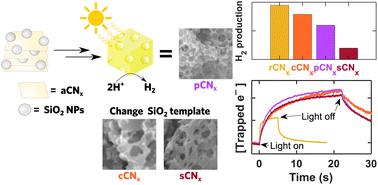Our official English website, www.x-mol.net, welcomes your feedback! (Note: you will need to create a separate account there.)
Soluble carbon nitride nanosheets as an alternate precursor for hard-templated morphological control
Nanoscale ( IF 5.8 ) Pub Date : 2022-09-06 , DOI: 10.1039/d2nr04129d Jasper Pankratz 1 , Emma Mitchell 1 , Robert Godin 1, 2, 3
Nanoscale ( IF 5.8 ) Pub Date : 2022-09-06 , DOI: 10.1039/d2nr04129d Jasper Pankratz 1 , Emma Mitchell 1 , Robert Godin 1, 2, 3
Affiliation

|
Carbon nitride (CNx) is an organic semiconductor with promising applications in solar energy conversion via photocatalytic water splitting. Current efforts are being devoted to improve the photocatalytic activity of CNx as it is limited by charge recombination which may be exacerbated by its low surface area. Hard-templated synthesis of CNx by filling mesoporous silica with small molecule precursors is one of the conventional approaches to improving the efficiency of CNx. However the relationship between activity and surface area has yet to be fully established. Herein we develop a new approach using soluble acidified CNx nanosheets as the precursor in an effort to decrease the potential for unintended chemical modifications and better understand the complex relationship between morphology and activity. Deprotonation of acidified CNx occurs at moderate temperatures to restore the π–π interactions. We prepared three modified morphologies with this synthetic route and completed a thorough study of the structural, optical, and photocatalytic properties. Supported by charge carrier dynamics studies, we found that the silica-templated CNx with modified morphologies suffered from higher trap state densities and resulted in lower photocatalytic activity compared to CNx prepared without a template. Characterization techniques showed that the chemical structure of the templated CNx obtained is not sensitive to changes in the silica template shape. Our observations highlight the complex relationship between structure, photophysics, and activity, and demonstrate that hard templating can modify more than the intended surface area.
中文翻译:

可溶性氮化碳纳米片作为硬模板形态控制的替代前体
氮化碳(CN x )是一种有机半导体,在通过光催化水分解的太阳能转换中具有广阔的应用前景。目前正在努力提高CN x的光催化活性,因为它受到电荷复合的限制,而电荷复合可能因其低表面积而加剧。通过用小分子前体填充介孔二氧化硅来硬模板合成CN x是提高CN x效率的常规方法之一。然而,活性和表面积之间的关系尚未完全确定。在此,我们开发了一种使用可溶性酸化 CN x的新方法纳米片作为前体,旨在减少意外化学修饰的可能性,并更好地了解形态和活性之间的复杂关系。酸化 CN x的去质子化在中等温度下发生,以恢复 π-π 相互作用。我们用这种合成路线制备了三种改性形态,并完成了对结构、光学和光催化性能的深入研究。在电荷载流子动力学研究的支持下,我们发现与没有模板制备的 CN x相比,具有改性形态的二氧化硅模板 CN x具有更高的陷阱态密度,并导致较低的光催化活性。表征技术表明,模板化 CN 的化学结构获得的x对二氧化硅模板形状的变化不敏感。我们的观察突出了结构、光物理学和活动之间的复杂关系,并证明硬模板可以修改的范围超过预期的表面积。
更新日期:2022-09-06
中文翻译:

可溶性氮化碳纳米片作为硬模板形态控制的替代前体
氮化碳(CN x )是一种有机半导体,在通过光催化水分解的太阳能转换中具有广阔的应用前景。目前正在努力提高CN x的光催化活性,因为它受到电荷复合的限制,而电荷复合可能因其低表面积而加剧。通过用小分子前体填充介孔二氧化硅来硬模板合成CN x是提高CN x效率的常规方法之一。然而,活性和表面积之间的关系尚未完全确定。在此,我们开发了一种使用可溶性酸化 CN x的新方法纳米片作为前体,旨在减少意外化学修饰的可能性,并更好地了解形态和活性之间的复杂关系。酸化 CN x的去质子化在中等温度下发生,以恢复 π-π 相互作用。我们用这种合成路线制备了三种改性形态,并完成了对结构、光学和光催化性能的深入研究。在电荷载流子动力学研究的支持下,我们发现与没有模板制备的 CN x相比,具有改性形态的二氧化硅模板 CN x具有更高的陷阱态密度,并导致较低的光催化活性。表征技术表明,模板化 CN 的化学结构获得的x对二氧化硅模板形状的变化不敏感。我们的观察突出了结构、光物理学和活动之间的复杂关系,并证明硬模板可以修改的范围超过预期的表面积。












































 京公网安备 11010802027423号
京公网安备 11010802027423号